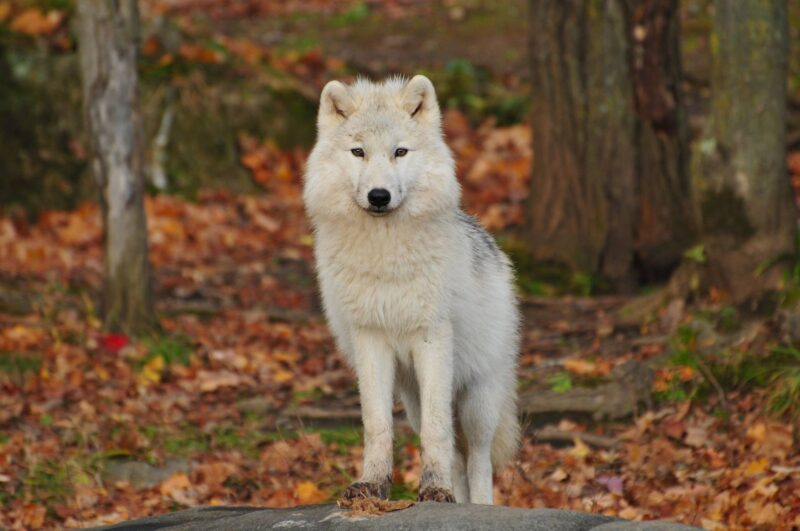Positive YouTube videos of wolves linked to greater tolerance

A new study from North Carolina State University suggests that people have more tolerance for wolves after seeing positive videos about them, which could make YouTube an important wolf conservation tool.
“One of the cool things about these results is that positive messaging was effective for changing people’s views. People had more positive attitudes, greater willingness to accept wolves, and were more likely to take action to help their conservation – no matter their political identity or their age – after watching positive videos,” said Nils Peterson, senior author of the study and a professor in NC State’s Department of Forestry and Environmental Resources.
“A lot of wildlife species we care about only need tolerance to persist in a landscape,” Peterson added. “They’re not domestic animals that need a lot of help from us. They just need us not to kill them or destroy their habitat.”
In the study, researchers evaluated how a group of 273 people rated their tolerance for wolves before and after watching either a playlist of five different negative videos, a playlist of five different positive videos, or a neutral video.
To measure their tolerance, researchers asked questions in three categories: they asked participants about their overall attitudes toward wolves, such as whether they thought wolves were “good” or “bad;” their level of acceptance of wolves in their state and near populated areas; and their intended behaviors, or whether they would be likely to act for or against wolves or their conservation.
Survey participants had positive attitudes, acceptance and behavior intentions about wolves prior to receiving any treatment, but researchers saw that positive videos could still increase attitudes, acceptance and participants’ willingness to act. They also saw those changes regardless of whether the viewer identified as conservative or liberal.
“Everybody is on social media these days, including state wildlife agencies, federal agencies, nonprofits, and everybody is putting content out there,” said the study’s lead author Will Casola, a Ph.D. student at NC State. “This study shows that this material actually has the potential to influence people, and they’re not just putting time and resources into something that goes in one ear and out the other.”
However, people who identified as liberal were more likely than conservatives to show positive changes in favor of wolves in measures of attitudes, acceptance and intended behaviors regardless of the videos they watched.
“We didn’t see anything that would suggest people reacted differently to each video treatment depending on their political affiliation,” Casola said. “Instead, we saw that no matter which videos they watched, liberals were more likely to exhibit positive changes.”
The largest changes in tolerance were linked to older age. People above the age of 40, regardless of political background, were more likely to have larger changes in their attitudes for or against wolves.
While negative videos also led to decreased tolerance for wolves, this change was less dramatic.
“There’s a lot of literature out there that shows that positively framed messages are more powerful than negatively framed messages, and these findings reinforce that,” Casola said.
Researchers saw improvements in respondents’ willingness to act for wolf conservation overall, but except for signing petitions to support wolf re-introduction, respondents showed reluctance to take other specific actions to aid wolf conservation.
“People in general said they weren’t likely to participate in many of these behaviors, but they were also less likely to participate in behaviors that were directly opposed to wolf recovery and conservation,” Casola said.
Researchers focused on wolves since they can be controversial. While researchers said wolves are essential for maintaining a diversity of species in a landscape and improving the health of populations they prey on, they can also compete with people for space and resources, and can pose a risk for livestock.
Researchers said one unanswered question in their work is about how effective the videos were at reaching people who may not already agree with the underlying message.
“People are already asking the question: How do we get media to cross ideological bubbles that people have created?” Peterson said.
——
The paper, “How do YouTube videos impact tolerance of wolves?” is published in the journal Human Dimensions of Wildlife. The paper was co-authored by Jaclyn Rushing, Sara Futch, Victoria Vayer, Danielle F. Lawson and Lincoln R. Larson of the NC State Department of Parks, Recreation and Tourism Management; and Michelle J. Cavalieri of the NC State Department of Biological Sciences. Researchers were supported by NC State’s Fisheries, Wildlife and Conservation Biology program, the Department of Forestry and Environmental Resources and the Department of Parks, Recreation and Tourism Management.
DOI: 10.1080/10871209.2020.1773582
Media Contacts: Nils Peterson, nils_peterson@ncsu.edu; Laura Oleniacz, News Services, ljolenia@ncsu.edu
*Reposted with permission from North Carolina State University*

 China
China